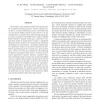Free Online Productivity Tools
i2Speak
i2Symbol
i2OCR
iTex2Img
iWeb2Print
iWeb2Shot
i2Type
iPdf2Split
iPdf2Merge
i2Bopomofo
i2Arabic
i2Style
i2Image
i2PDF
iLatex2Rtf
Sci2ools
CVPR
2006
IEEE
2006
IEEE
Hidden Conditional Random Fields for Gesture Recognition
We introduce a discriminative hidden-state approach for the recognition of human gestures. Gesture sequences often have a complex underlying structure, and models that can incorporate hidden structures have proven to be advantageous for recognition tasks. Most existing approaches to gesture recognition with hidden states employ a Hidden Markov Model or suitable variant (e.g., a factored or coupled state model) to model gesture streams; a significant limitation of these models is the requirement of conditional independence of observations. In addition, hidden states in a generative model are selected to maximize the likelihood of generating all the examples of a given gesture class, which is not necessarily optimal for discriminating the gesture class against other gestures. Previous discriminative approaches to gesture sequence recognition have shown promising results, but have not incorporated hidden states nor addressed the problem of predicting the label of an entire sequence. In t...
Computer Vision | CVPR 2006 | Discriminative Sequence Model | Generative Hidden State | Gesture Class | Hidden Markov Model | Hidden State Structure |
| Added | 12 Oct 2009 |
| Updated | 12 Oct 2009 |
| Type | Conference |
| Year | 2006 |
| Where | CVPR |
| Authors | Sy Bor Wang, Ariadna Quattoni, Louis-Philippe Morency, David Demirdjian, Trevor Darrell |
Comments (0)

